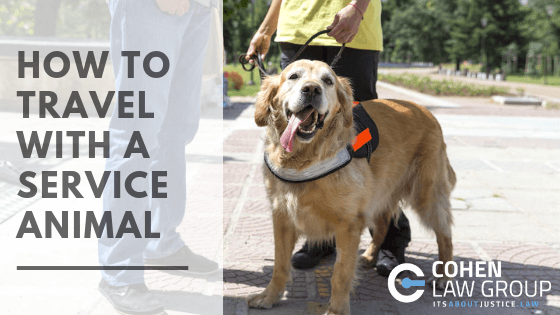How To Travel With A Service Animal
Millions of Americans are preparing to travel for the upcoming holiday season, filling airports with anxious jetsetters just trying to make it to their next destination. For those millions of travelers, air travel is hardly an enjoyable or convenient experience. For disabled travelers like Lisa McCombs, however, the airport is not just a place of inconvenience, but it can also be a place of debilitating stress and embarrassment (1).
McCombs, a decorated veteran of Army deployments in Iraq and Afghanistan suffers from PTSD and utilizes her service dog, Jake, to help her calm her nerves. However, McCombs is suing American Airlines after a 48-hour ordeal left her embarrassed and without answers.
Her suit alleges that American Airlines agents in Manhattan, Kansas refused to allow her to board her flight home with Jake. She goes on to say that the agents demanded to know the nature of her disability and explain how Jake helps her cope with it.
She went on to inform them that Jake was a service dog and not a pet, and that he was fully documented as a service animal. After being unable to board two flights, McComb was finally able to board a third, but the ordeal in Kansas would last for two days before she was finally able to return home to Mississippi.
Tips for Travel
The Air Carriers Access Act (ACAA) covers the regulations for commercial airlines with regard to disability access in the same way the Americans with Disabilities Acts covers most public places. If you are travelling with a service animal, here are a few points to keep in mind with regard to your rights under the ACAA:
1. Allow for extra time getting through security. Moving through security with a service animal may be more likely to set off a scanner or metal detector, so prepare for the possibility of additional screening while also making the security personnel aware that the animal is a service animal, rather than a pet.
2. The ACAA and Department of Transportation regulations require that airlines allow service dogs on flights without any additional ticketing charge and by presenting documentation or providing “credible verbal assurances” that the service animal is needed.
3. There is no limits to the number of service animals permitted on a single flight, and an airline may not require that the service animal be confined to a cage.
4. If a seating assignment cannot work with a service animal with the owner, the airline must offer the owner the opportunity to move to a seat that can accommodate the animal.
Federal regulations have been crafted to allow persons with disabilities to travel with as much convenience as possible.
The regulations also provide methods for filing a complaint when the rights provided by the ACAA or ADA have been violated. At Cohen Law Group, this is just one of many examples of the types of cases we may be able to help with. If you feel that you’ve been wrongly denied an accommodation that should be provided to you by the Americans With Disabilities Act, the Air Carriers Access Act, or if you simply have questions about it, please do not hesitate to contact us.
References:
(1) https://www.washingtonpost.com/news/checkpoint/wp/2016/10/29/a-combat-veteran-with-ptsd-wasnt-allowed-to-fly-with-her-service-dog-so-she-sued/
DISCLAIMER: This website is for informational purposes only and does not provide legal advice. Please do not act or refrain from acting based on anything you read on this site. Using this site or communicating with Cohen Law Group through this site does not form an attorney/client relationship. This site is legal advertising. Please review the full disclaimer for more information by clicking here.

